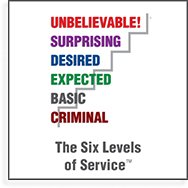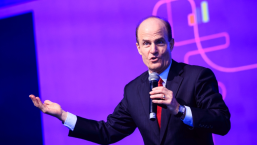Your customers have always been your focus. This is true whether you serve clients, colleagues, patients, visitors, or guests. You create processes to make their experience smoother. You listen to their feedback so you can better meet their needs.
You know that you only have so many tries to get it right. In many cases, you might only get one try: 66% of B2B and 52% of B2C customers stop buying after a single poor customer service interaction.
 As a result, companies implement customer service training programs and seek to measure satisfaction and loyalty on every level, creating a glut of surveys and e-mails imploring customers to write reviews.
As a result, companies implement customer service training programs and seek to measure satisfaction and loyalty on every level, creating a glut of surveys and e-mails imploring customers to write reviews.
In their earnest intention to discover whether their existing service has appealed to customers, companies overlook the most important question to ask: What do our customers actually value? Is it a quick point-of-sales process? The ability to speak with a human being when they have a problem? Low prices? Loyalty points? What has the most value to them?
Given that people are diverse in their wants and needs, that can sound like an unanswerable question. But not for us.
We have a simple, powerful answer: respond to what matters to each customer in the moment.
the extra mile.
This is a level of service excellence we call unbelievable: something customers didn’t expect or even know they wanted. But when they experience it, they are delighted. The power of unbelievable service can undo negative impressions and guarantee future engagement. The more unbelievable experiences you create, the more you will reduce complaints, grow your company, and improve your reputation.
So, how in the world does a company create an unbelievable level of service exactly when it’s needed, where it’s needed, and do it over and over again, for every customer, every day?
Empower people like that to lead their teams and you’ll start to drive change exactly where it’s needed, based on service excellence education and application that team members drive themselves.
The following five best practices are fundamental to adopting this flexible, bottom-up approach to customer experience improvement:
- Shift service orientation from disparate ideas and concepts to a common service
language - Shift engagement with staff from isolated trainings to self-led and continuous education
- Shift initial focus from external customers to internal partners
- Shift perspective from internal process points to customer perception points
- Shift measurement from lagging indicators to leading indicators
That may sound like a lot of shifting, but each works in concert with the rest. Let’s take a closer look at the practical steps you can take now to implement each of these points of view.

1. Shift orientation from disparate ideas and concepts to a common service language.
No two departments (or teams or individuals) have exactly same vision for unbelievable service. Each group has a different understanding of the attention, resources, processes, and systems needed to improve customer experiences.
Many organizations adopt standardized customer service training programs in order to manage these differing perspectives. But that’s the wrong approach. First, we need to identify a common and consistent language that we’ll use to communicate about serving customers. Building that common language starts by building a shared vocabulary that helps unify the attention and actions of teams across the customer journey.
In most companies, service language is determined more by a person’s function and less by the internal or external customers they serve. For example, operations managers may view service from a consistency, quality, and process point of view. They may use vocabulary like “defect
rates,” “cycle times,” and “cost ratios.” Contrast this language with what sales people use: “customization,” “partnership,” or “building trust.” Each set of words is appropriate and has value to the customer and the organization, but how can those perspectives perform better from a single song book: the customer experience song book?
Language is powerful. It is the key driver for new action and a vital connector for making a change or improvement in customer experience.
We start building this common language by defining service as “taking action to create value for someone you care about.” This definition holds true for everyone in an organization irrespective of their functions, departments, or titles. This common core definition focuses on the well being of the customer (or partner, or colleague) and the value they perceive, not the activities or steps we take to fulfill our segment of the process.
 Next, we define every level of customer experience possible, and then rank where each team’s contribution to that experience stacks up. In our training, we define Six Levels of Service, ranging from Criminal to Unbelievable. The words used are less important than educating people to adopt this point of view. When everyone on a team – and, ultimately across the organization – uses the same language to describe customer experience at any point of contact, you have the beginning of a strong cultural shift.
Next, we define every level of customer experience possible, and then rank where each team’s contribution to that experience stacks up. In our training, we define Six Levels of Service, ranging from Criminal to Unbelievable. The words used are less important than educating people to adopt this point of view. When everyone on a team – and, ultimately across the organization – uses the same language to describe customer experience at any point of contact, you have the beginning of a strong cultural shift.
Here are three practical steps you can take to create a common service language with your teams:
- Review the language already being used. Are there words or jargon about customers and service that are frequently communicated? These could be phrases in scripts, service standards, job descriptions, or training manuals. The language could be internal slang words or acronyms unique to your team or organization. Does this language help your team appreciate the urgent need of a customer or celebrate a positive win in customer experience?
- Identify which elements in your current language encourage continuous improvement in your team’s service culture. Choose words and phrases that focus on the customer experience—that is, words customers might use—not just words describing your own internal process. What words would you want to hear employees use to describe your service to their friends? What words will differentiate levels of service experience in a useful manner?
- Embed this language in everything that affects customer experience from the perspective of your team. Think of processes, procedures, scripts, or activities that might need to be amended. Ensure leaders support and reinforce the language you’ve chosen as your fundamental and common service language.

2. Shift engagement with staff from isolated customer service training’s to self-led continuous education.
When companies decide to improve service, they often try to write better scripts, or training their employees intensively on product knowledge and procedures. Even mystery shopping—clearly, a customer-focused effort—is mostly to ensure that procedures are being used correctly or that scripts are being followed.
This extreme focus on which actions to take and how to take those actions misses the essence of customer experience entirely. And it’s the biggest reason that millions of dollars spent annually on customer service training provide little lasting improvement.
The crux of customer experience is not the service action itself but the value the customer perceives from that action.
Because different customers value different things, training that focuses on scripts, standards, and procedures can lead to robotic responses with inconsistent and sometimes deeply dissatisfying outcomes. It certainly won’t make any experience unique or personally satisfying. And “personally satisfying” is where the highest level of customer experience differentiation lies.
 Through our work with clients in B2B and B2C industries, we’ve found that a dramatic shift occurs when teams are educated to understand service excellence and empowered to take an action that delivers more value.
Through our work with clients in B2B and B2C industries, we’ve found that a dramatic shift occurs when teams are educated to understand service excellence and empowered to take an action that delivers more value.
Our curriculum establishes a continuous learning foundation that delivers value for customers and consistently creates more value than those customer received in the past.
When this perspective shifts, team members start to ask and answer new service questions: “Who am I going to serve? What do my customers care about most? What do they appreciate? What do they want experience or achieve?”
This focus on stepping up to provide more value guides people to focus on what will be Unbelievable for the customer rather than worrying about “How will I score on my metric?”
And this shift of focus works just as effectively for internal service teams. Once internal teams start working to better serve the needs of their colleagues and service partners, the infectious and uplifting service mindset spreads to external customers as well.
Here are four practical steps you can take to encourage your teams’ ongoing education and continuous generation of new service ideas.
- Involve your whole team and include members of other service teams. This way you build understanding, inspiration, and action across the organization, not just in individuals within certain departments.
- Discuss with your team the organization’s vision and brand. What kind of customer experiences you want to create? What mindset do your people need to have? What attitudes, perspectives and collaboration does this require?
- List the key service transactions your team members undertake with customers, colleagues, or other service partners. Identify everyone who directly or indirectly affects that transaction.
- Bring these people together to explore the transaction from all sides. Recognize who needs to collaborate and what processes will be involved to create Unbelievable

3. Shift initial focus from improvement for external customers to improvement with internal partners.
Most customer service trainings place an initial focus on employees who interact daily with external customers and clients. This is a common mistake.
Customer-facing employees recognize the importance of creating satisfied customers, as they are first in line to receive compliments and complaints.
But for many who work inside the organization, the idea of colleagues as recipients of their service, and the need to continually improve that service, may not be top of mind.
It is essential to focus on educating colleagues and partners about their role as providers of Unbelievable service internally, and as key contributors to external customer experience.
 Why? Asking those on the frontline to go the extra mile for a customer is difficult if they are not receiving extra-mile support from internal functions, such as finance, HR, or IT.
Why? Asking those on the frontline to go the extra mile for a customer is difficult if they are not receiving extra-mile support from internal functions, such as finance, HR, or IT.
Focusing service improvement efforts exclusively on those who are customer-facing not only frustrates those serving in front, but also upsets team members in supporting functions who don’t understand why their customer-facing colleagues are always demanding this or that improvement.
Without shared context and mutual commitment to differentiating on customer experience, employees working behind the scenes may push back at those working in the front, frustrating both parties and making it difficult for the frontline to deliver the outstanding customer experiences they know they could.
Service improvement can progress quite quickly and is more sustainable when internal and shared services improve first, or they improve together in sync with the frontline’s efforts.
What Happens When You Start with Internal Partners.
At our client Nokia Siemens Networks (NSN, now Nokia Networks), the frontline team’s ability to serve customers was highly dependent on service and support from NSN’s software developers and hardware manufacturers, who were located far from their customers’ sites.
As the frontline team tried to provide end customers with better service – through greater responsiveness, flexibility, or speed – the software developers and factory teams judged many of the incoming new requests as inappropriate, unnecessary, or even unreasonable. Only after months of frontline frustration did NSN bring their software developers and factory employees into the “customer” service improvement program.
In the following year, with greater internal as well as external service, NSN captured many competitive wins and scored gains of up to 20% in customer satisfaction among key customers.
A survey of the first 6,000 NSN employees who participated in the customer service excellence program rated their satisfaction with the company’s culture significantly higher in eight categories, including engagement, collaboration, and communication.
We have also found that managers of internal functions, including manufacturing, logistics, HR, IT, finance, legal, facilities, and security are consistently surprised by the enthusiasm and creativity of their teams to improve internal service, once they are given the time and tools to unleash the ideas that are available right beneath the surface.
Here are four practical steps you can take to shift the focus of customer experience from external to internal:
- What internal teams do your frontline staff rely on to support customer experience touch points? Work with those people to uncover internal service issues and opportunities for improvement. As these improvements occur, external experiences can also be readily stepped up.
- Pay attention to the engagement of your teams. Consistently high customer satisfaction relies on consistently high employee engagement. Create communication programs, recognition programs, contests, and other activities to encourage the teams you count on to become more actively focused on service excellence and continuous innovation.
- Constantly reinforce for internal teams how their work affects external customer experience and adds value to customers.
- Use the same service language, principles, and education for teams serving colleagues and partners internally as you do for those serving customers, consumers, and clients externally.
Start on the Path to Uplifting Service Today
Speak with a strategist to explore what’s possible for your organization.
Gain clarity on your biggest and most valuable opportunities.
Discover how we can help you achieve your service goals.

4. Shift perspective from internal process points to customer Perception Points.
Traditional customer service training focuses on improving process. But with that focus, we miss the opportunity to improve the customer’s experience of our process.
You can create those opportunities with teams by mapping customer Perception Points: the key moments where customers perceive their experience and form opinions about your team, your company, and your brand.
How service feels is often more important to customers than the speed or accuracy of your process.
How often have you recommended a service provider because the experience felt great – even if the process wasn’t perfect? A powerful example of this is when companies like Zappos discovered that customers would buy more online when they could return items easily, at no extra cost. Though solved by a process, that breakthrough came by improving a Perception Point: customers worried that ordering online was risky because they would be stuck with shoes that didn’t fit.
Introducing service innovation to customer Perception Points is faster, easier, and less expensive than process improvements and creates more memorable customer experiences.
Perception Points are often found between or around process points. For example: staff attitudes, service styles, user-friendliness, ease of finding information, room temperature, odors, tone of communications, recognition, and appreciation – these are just a few of the Perception Points in customer experience, but they do not necessarily appear in process maps.
 For example, telephone skills training for sales representatives usually covers how to use the integrated telephone and CRM system and which scripts to use when responding to special requests or complaints. However it doesn’t routinely address the most important moments when customers need a quietly nuanced or emotionally empathetic response to individual circumstances.
For example, telephone skills training for sales representatives usually covers how to use the integrated telephone and CRM system and which scripts to use when responding to special requests or complaints. However it doesn’t routinely address the most important moments when customers need a quietly nuanced or emotionally empathetic response to individual circumstances.
When you meet customers in their individual circumstances and show you care by responding with an unscripted, yet appropriate action, you gain considerable customer appreciation and loyalty – even advocacy.
Perception Points are so powerful, they can help you overcome weak process points.
For example, some processes require steps you can’t control, steps your customers will never enjoy. Studying and improving the Perception Points surrounding these process steps can make all the difference, such as a friendly voice, a follow-up phone call, a humorous video, or helpful FAQs.
Moreover, mapping customer Perception Points can be applied to any business procedure, whether it involves direct customer interactions, working with internal partners or shared services, or backroom operations.
We have helped organizations map Perception Points for hundreds of service transactions, and in every case, teams are surprised by how quickly and easily human attention to Perception Points improves customer experience.
Routinely, up to 75% of Perception Point improvement ideas can be done immediately, at zero or little cost, and without the approval of a committee, a task force, or senior management.
Here are practical steps you can take to help your teams map and thus improve their customer Perception Points:
- Identify the key service transactions within your customer journeys and review the process steps for these transactions.
- Identify where process improvements may be necessary and where process cannot be changed but may be hindering customer experience.
- Now look at the Perception Points in and around this process. Stand in the customer’s shoes and ask these questions:
- What do I see, hear, touch, smell, taste, and feel throughout the transaction?
- How easy is this process? What options do I have?
- Do I get priority treatment as a first-time or repeat customer?
- Am I treated with respect? Are staff friendly to me?
- Are digital forms and paperwork user-friendly?
- Are directions clear and well-documented? Is there good signage at each step of the procedure?
- Is my order reviewed and confirmed?
- Is all communication responded to accurately and quickly?
- Is it easy to get my questions answered?

5. Shift measurement from lagging traditional 5 indicators to leading service indicators.
It’s easy to be overwhelmed by the number of ways to measure customer service, including satisfaction rank, NPS scores, number of complaints and compliments, performance to standards, customer loyalty, confirmed referrals, share-of-wallet, share-of-mind, share-of-market, and more.
These traditional measures are not wrong or unimportant, but we’ve helped many companies achieve dramatic service transformation by shifting their focus to measures that actually matter more for improving customer experience. The important difference about those powerful metrics? They measure leading indicators, not lagging ones.
The problem with lagging indicators is that the data arrive too late – they come only after the customer service experience could have been improved.
Finding out that customer complaints have risen by 15% means your customer experience team must dig out of the hole first, then work even harder to become competitive.
By advancing the first four best practices we just outlined, your team or department members will be focused proactively on generating new ideas and taking new actions to create value exactly where it matters for your customers.
Measuring the number of these new ideas and new actions is the vital step towards becoming an organization that consistently delivers Unbelievable experiences – attracting new customers, retaining loyal ones, and driving revenue gains.
To measure whether your teams’ new ideas and actions are improving service to customers and fostering internal cooperation, use this sequence of leading to lagging metrics:
- Measure your teams’ understanding and application of the common service language (established in Step 1).
- Count and consistently increase the number of new service ideas created by your service teams.
- Count and increase the number of new actions taken to implement the new ideas your teams create.
- Track the increase in compliments and/or decrease in complaints from your customers or internal partners.
- Apply proven survey and assessment tools to measure improvements in customer satisfaction, customer loyalty, and employee engagement.
- Measure the business value in higher revenue, lower cost, greater profitability, or increased share that yield from the steps you have taken above.
Competing on customer experience means prioritizing future wellbeing and serving in ways that are supremely caring, human, and interactive.
With the five best practices outlined here, your organization can reset the standard every day by understanding, creating, and delivering uplifting customer experiences.
Go Beyond Run-of-the-Mill Customer Service Training and Create a Culture of Uplifting Service in Your Organization.
After decades of partnering with leaders, teams, and companies all over the world, we have developed a Proven Path to Uplifting Service. We will help you follow this path to achieve the goals and deliver the results most important for you.
Start on the Path to Uplifting Service Today
Speak with a strategist to explore what’s possible for your organization.
Gain clarity on your biggest and most valuable opportunities.
Discover how we can help you achieve your service goals.






